 : American
English Idioms - Letter K : American
English Idioms - Letter K
Today learn idioms beginning with the letter K. |
BLUE UPPER CASE LETTERS =
video and detailed written definition and usage
blue lower case letters =
video definition and usage
BLACK UPPER CASE LETTERS =
detailed written definition and usage
black lower case letters =
brief written definition and usage |
|
Idiom |
Definition |
Usage |
|
KANGAROO COURT |
a court set up outside the regular legal system; staged
trial where the outcome is set from the beginning |
1. The rancher and his friends tried and convicted the horse
thieves in a kangaroo court rather than let the sheriff take
them to jail for a trial according to the law.
2. The political protesters had been tried and found guilty
in a court of law, and when the verdict was read, they
claimed that the jury and judge had not been impartial, and
that they had been tried in a kangaroo court. |
| keel over |
faint and fall over |
He thought that he was
going to keel over because of the heat. |
| keel over |
tip over |
The boat looked like it
was going to keel over. |
| keep a secret |
not tell others |
You should keep
a secret about your new job. |
| keep a stiff
upper lip |
face the situation with
pride |
The team could
keep a stiff upper lip even though they were
defeated. |
| keep after |
keep reminding |
You should keep
after her to do her homework. |
| keep an eye on |
Watch |
Keep an eye on
my bicycle while I order some coffee. |
| keep at |
continue |
He has decided to
keep at his studies at the university. |
| keep body and
soul together |
survive |
It was very cold during
the winter but somehow she was able to keep body and
soul together. |
| keep books |
keep records of money
gained and spent |
She used to keep
books for a small company. |
| keep down |
control |
The students were told
to keep down the noise. |
| keep from |
refrain from |
I could not keep
from eating all that cake. |
| keep good time |
accurately report the
time |
My watch does not been
keep good time lately. |
| keep house |
look after household |
She likes to
keep house more than working for a company. |
| keep in touch |
stay in contact |
I have always tried to
keep in touch with my friends. |
| keep on |
continue |
She will keep on
making the same mistakes. |
| keep one's chin
up |
continue and not quit |
Try and keep
your chin up. |
| KEEP
(ONE’S) COOL |
to stay calm under stress; not to become angry
Synonym: hold/lose (one’s) temper
Antonym: lose (one’s) cool, hot under the collar; see red |
1. I know you’re angry, but you’ve got to try to control
yourself. Keep your cool and don’t lose your temper.
2. It’s particularly important to keep your cool in a
traffic jam. It’s so easy to get angry and have an accident. |
| keep one's eye
on the ball |
be watchful and ready |
You should keep
your eye on the ball or you will make a mistake. |
| KEEP
(ONE’S) EYES PEELED |
to be alert and watchful; to look very carefully for
something or someone
The expression suggests that one’s eyelids are pulled back
in order to not miss seeing anything. |
1. I’m looking for a special edition of a book, and I
haven’t found it anywhere. When you’re in the bookstore,
please keep your eyes peeled for it, will you?
2. They planned to meet Joe on a crowded corner at
lunchtime. He hadn’t arrived yet, but as people walked
toward the corner, they kept their eyes peeled for him. |
| KEEP
(ONE’S) FINGERS CROSSED |
to hope for something; to wish for luck
The expression probably originates from a superstition that
bad luck can be prevented by crossing one’s fingers. The
expression refers to crossing one’s middle finger over the
knuckle of the index finger. |
1. Jane wasn’t sure that she had passed the test, but she
was keeping her fingers crossed.
2. They are keeping their fingers crossed that the rain
holds off and doesn’t spoil the picnic they have planned. |
| keep one's head |
stay calm when there is
trouble or danger |
He is a very good leader
and is always able to keep his head. |
| KEEP
(ONE’S) HEAD ABOVE WATER |
to just barely manage to stay ahead, financially (sentence
1) or with one’s work or responsibilities (sentence 2)
Antonym: in over (one’s) head
Compare to: make ends meet; get by
Keep one’s head above water and make ends meet mean having
just enough money but no extra, although the former conveys
a greater feeling of desperation. Keep one’s head above
water can mean survival in a financial or other sense,
whereas make ends meet always refers to a financial
situation. |
1. Mrs. Robinson has three children to support and she
doesn’t make very much money at her job. She is barely
keeping her head above water.
2. Peter is having a difficult time at the university
because he wasn’t very well prepared academically, but he is
somehow managing to keep his head above water. |
| keep one's mouth
shut |
be quiet |
She was very angry and
told him to keep his mouth shut. |
| keep one's nose
clean |
stay out of trouble |
He has been managing to
keep his nose clean since he moved to the
new town. |
| KEEP
(ONE’S) NOSE TO THE GRINDSTONE |
to work hard without rest
The expression usually refers to monotonous work. |
1. You will succeed if you keep working hard, but you have
to keep your nose to the grindstone.
2. Kim is studying constantly now because she has final
exams next week. She’s in her room keeping her nose to the
grindstone. |
| keep one's own
counsel |
keep ideas and plans to
himself |
He always seems to
keep his own counsel. |
| KEEP
(ONE’S) SHIRT ON |
to stay calm or be patient when someone wants to hurry
Synonym: hold (one’s) horses
Antonyms: shake a leg; step on it
The expression is generally used in the imperative. It is
used by an adult to children, a superior to a subordinate,
or between two equals on friendly or intimate terms. |
1. Will you keep your shirt on, Bob? You won’t get there any
faster if you drive too fast and cause a car accident.
2. I know you’re hungry, but dinner won’t be ready for
another ten minutes. Just keep your shirt on! |
| KEEP
(ONE’S) WITS ABOUT (ONE) |
to pay attention and be ready to react
Compare to: at (one’s) wits’ end, scared out of (one’s) wits |
1. If she wants to do well in her job interview, she can’t
daydream—she’ll have to keep her wits about her.
2. When I travel, I’m always careful to keep my things with
me in crowded places. I keep my wits about me. |
| keep one's word |
fulfill her promise |
She never can
keep her word. |
| keep pace with |
go as fast as |
It was difficult to
keep pace with the other students. |
| keep quiet |
remain silent |
Please keep
quiet and listen to the instructor. |
| KEEP
(SOMEONE) AT ARM’S LENGTH |
to keep someone at a distance emotionally |
1. You can’t expect people to be very friendly to you when
you always keep them at arm’s length.
2. Craig thinks that if he keeps everyone at arm’s length,
he won’t fall in love and get hurt. |
| KEEP
(SOMETHING) UNDER (ONE’S) HAT |
to keep something secret
Antonyms: spill the beans; let the cat out of the bag
This phrase originates from the 1800s, when many men and
women wore hats. The idea is to keep a secret in your head,
underneath a hat. |
1. Don’t tell Richard anything you don’t want everyone else
to know. It’s impossible for him to keep anything under his
hat.
2. I’m not telling anyone yet, but Tom and I are getting
married. Keep it under your hat, okay? |
| KEEP
THE BALL ROLLING |
to maintain momentum; to keep some process going |
1. The principal has done so much and worked so hard to
improve this school. Who’s going to keep the ball rolling
when she retires?
2. Mr. Preston had managed to motivate his employees to
higher production levels, and he wanted to keep them going.
He wondered how he could keep the ball rolling. |
| keep the books |
keep records of money
gained and spent |
The head of the
accounting department will keep the books
this year. |
| keep track of |
record |
The company will
keep track of the money spent on paper this month. |
| KEEP UP
WITH THE JONESES |
to have the same standard of living as one’s friends and
neighbors do
The expression implies that one strains one’s financial
resources when one tries to match or exceed the purchases or
actions made by a neighbor. Jones is a common family name. |
1. My wife seems to think that we should buy our children
cars of their own just because most of our friends do. She
seems to think we have to keep up with the Joneses.
2. Keeping up with the Joneses can be very expensive. Every
time your neighbor improves his home or buys a new car, you
feel you have to, too. |
| keep
you on your toes |
|
|
| keep
your chin up |
|
|
| keep
your eye on the ball |
|
|
| KEYED
UP |
full of nervous anticipation; anxious; tense |
1. Stop pacing the floor. Relax. Why are you so keyed up?
2. Charles was so keyed up waiting for the wedding to begin
that when it finally did, he dropped the wedding ring. |
| kick out of |
enjoyment from |
I get a kick out
of watching him paint. |
| KICK
THE BUCKET |
to die
The expression can be either disparaging or light-hearted
when used about oneself or one’s relatives (sentences 1 and
2), or disrespectful and impolite when used about someone
else (sentence 3). |
1. I plan on spending all my money before I kick the bucket.
I’m not going to leave a penny of it to my relatives.
2. Your father hasn’t yet made a will. He doesn’t plan on
kicking the bucket anytime soon.
3. The old woman was a person everyone in the neighborhood
disliked. There were not too many mourners when she kicked
the bucket. |
| kick
the can down the road |
|
|
| KICK UP
(ONE’S) HEELS |
to have a lively and fun time, usually at a party or dance.
The expression is commonly used to describe someone who is
ordinarily quiet and reserved and for whom having a lively
time is unusual. |
1. Mr. and Mrs. Taylor are certainly having a good time at
the party. They haven’t kicked up their heels like this for
years
2. Put down your work, get out of the house, and come to the
dance. Why don’t you kick up your heels for a change? |
| KILL
TWO BIRDS WITH ONE STONE |
to accomplish two objectives with one action |
1. I have to go to New York on business this Friday, and
I’ve needed to get some new suits for some time. Maybe I can
kill two birds with one stone: I’ll attend to my business in
New York on Friday and Monday and do some shopping over the
weekend.
2. I need to get rid of all the old baby clothes I had for
my children when they were small. Since you are about to
have your first baby, why don’t I give the clothes to you?
We’ll kill two birds with one stone. |
|
KNEE-HIGH TO A GRASSHOPPER |
very young
The expression suggests that the person is only as tall as a
grasshopper’s knee and is therefore very young. It is often
used with a facedown, open hand to indicate the young
person’s height at the time. |
1. I was just knee-high to a grasshopper when I first went
fishing with my father. I couldn’t have been more than five
years old.
2. Look how small these pants are! I must have been
knee-high to a grasshopper the last time I wore them. |
|
KNOCK/THROW (SOMEONE) FOR A LOOP [KNOCKED/THROWN FOR A LOOP] |
to shock, surprise, or astound someone
Compare to: pull the rug out from under (someone); spring
something on (someone) |
1. The teacher threw me for a loop when she told me I had
failed the exam. I thought I had done so well.
2. Alan was knocked for a loop when he found out he had won
$5,000 in the lottery. |
| knocked up |
pregnant |
My dog gets
knocked up once a year. |
| knock
your socks off |
|
|
| KNOW
BEANS ABOUT SOMETHING, NOT |
to know very little about something; to speak without
authority on some topic
Similar to: talk through one’s hat |
1. Rita’s interpretation of that artist is completely wrong.
Don’t listen to her. She doesn’t know beans about it.
2. Sometimes you go on and on as though you’re an expert. I
bet you don’t know beans about half the things you think you
do. |
| KNOW IF
(ONE) IS COMING OR GOING, NOT |
to be confused and disoriented.
Antonyms: on the ball; get/have (one’s) act together Compare
to: out to lunch |
1. Nancy thought yesterday was Wednesday and now she thinks
today is Sunday. She doesn’t know if she’s coming or going
2. First I packed all the wrong clothes, then left the bag
behind, and waited for the taxi until I realized I had
forgotten to call one. When it came, I couldn’t remember
where I wanted to go. I don’t know if I’m coming or going. |
| KNOW
(SOMEONE) FROM ADAM, NOT |
to be unable to recognize someone because the person is a
stranger |
1. Who is that speaking at the podium? Is it the chairman? I
don’t know him from Adam.
2. A strange woman approached us at the train station. I
assumed that she was Mrs. Smith, whom we were supposed to
meet, but it was hard to tell since we didn’t know Mrs.
Smith from Adam. |
| KNOW
THE INS AND OUTS |
to be familiar with the details and hidden meanings of an
activity or situation
Compare to: know the ropes
Know the ropes is more frequently used to describe knowing
the procedures to follow in a situation (knowing how to do
something), whereas know the ins and outs more often
describes the complex and hidden details of a situation. |
1. When you travel to a foreign country, it is wise to hire
a guide if you don’t know the ins and outs of the place.
2. American businesses often hire host country nationals to
help them do business in foreign countries because the host
country nationals know the ins and outs of doing business
with their own countrymen. |
| |
to be familiar with a task or situationAntonym: wet behind
the ears
Compare to: learn the ropes; know the ins and outs
Know the ropes is more frequently used to describe knowing
the procedures to follow in a given situation (how to do
something), whereas ins and outs more often describes the
complex and hidden details of a situation. |
1. Let Marilyn help you get the manuscript published the
first time. She knows the ropes and she’ll save you a lot of
time and effort.
2. You have to know the ropes if you want to get hired in
this city. Employers are looking for people with connections
and know-how, not untried youngsters fresh out of college. |
| KNOW
THE ROPES |
|
|
| KNUCKLE
DOWN |
to do one’s work seriously; to apply oneself fully; to get
busy |
1. The young man hadn’t been studying very much and now he
was failing his courses. The student advisor told him he
would have to knuckle down if he wanted to avoid being
expelled.
2. Mary frequently complains that she doesn’t have enough
time to finish her work. But if she would spend less time
chatting and just knuckle down, she would get it done. |
| KNUCKLE
UNDER |
to submit or give in to pressure
Antonyms: stand (one’s) ground; stick to (one’s) guns |
1. Don’t let society beat you down or make you be the way
everyone else is. Don’t knuckle under.
2. The mob leader promised that they would never make him
reveal his partners in crime, no matter how badly they
treated him. He swore he would never knuckle under. |
|
|
More Idioms |
|
|
Additional Lessons |
 About These
Lessons About These
Lessons
The following classroom lessons are great for students
who want additional listening and reading practice. |
-
Travel America -
Beginner
Level. Do you love America and American
English? Learn before you travel. Facts and other
cool stuff about your favorite U.S. state. Great
English reading practice.
|
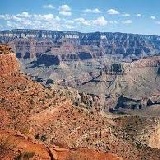 Travel
America - California Travel
America - California
(Beginner -
Reading)
Learn some interesting facts and read interesting
stories about California. |
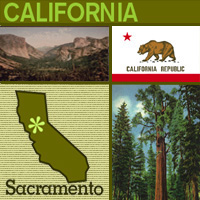 California California
Nicknamed the "Golden State," California is the
third largest state in area after Alaska and Texas.
The discovery of gold and the immigration in 1849 of
thousands of "forty-niners" in search of the
precious metal helped California's admission into
the Union in 1850. Today, California, land of the
giant redwoods, has the highest population of any
state in the nation and is America's principal
agricultural state. It is also the home of
Hollywood, the center of America's movie and
television industry. Its capital is Sacramento and
the state flower is the golden poppy. |
 California
State Flag California
State Flag
Designed by William Todd (nephew of Mary Todd
Lincoln, wife of Abraham Lincoln), the historic bear flag
was raised at Sonoma, California in 1846 by American
settlers in revolt against Mexican rule (officially adopted
as the state flag of California in 1911).
Symbols on California's Flag
The once common California grizzly bear (also the official
state animal) portrays strength; the star represents
sovereignty; the red color signifies courage; and the white
background stands for purity.
The Bear Flag Revolt
On June 14, 1846, a small band of settlers marched on the
Mexican garrison at Sonoma and took the commandant prisoner.
They issued a proclamation which declared California to be a
Republic independent of Mexico. This uprising became known
as the Bear Flag Revolt (after the hastily-designed flag
depicting a grizzly bear and a five pointed star over a red
bar and the words "California Republic."
The grizzly bear was a symbol of great strength while the
star made reference to the Lone Star of Texas. The flag only
flew until July 9, 1846 when it was learned that Mexico and
the United States were already at war. Soon after, the Bear
Flag was replaced with the American flag. It was adopted as
the State Flag by the State Legislature in 1911. |
|
Source:
State Symbols USA |
|
|
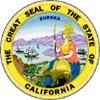 California
State Facts California
State Facts
Picture: state seal of California |
|
State Capital |
Sacramento |
|
Nickname |
The Golden State |
|
Motto |
Eureka (I have found it) |
|
Statehood |
September 9, 1850 (31st) |
|
Origin of Name |
Named by the Spanish after Califia, a mythical
paradise in a Spanish romance written by Montalvo in
1510. |
|
Largest Cities |
Los Angeles, San Diego, San Jose, San Francisco,
Long Beach |
|
Border States |
Arizona, Nevada, Oregon |
|
Area |
155,973 sq. mi.; 3rd largest |
|
State Bird |
California Valley Quail |
|
State Flower |
Golden Poppy (eschscholtzia californica) |
|
State Tree |
California redwood (sequoia sempervirens) |
|
State Song |
I Love You, California |
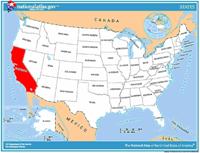 Travel and tourism site for California - The official travel
site for the state of California. Travel and tourism site for California - The official travel
site for the state of California. |
|
|
California Stories |
|
|
Old Spanish Days in Santa Barbara
Have you ever been to a real, authentic fiesta? Every year in
August, the city of Santa Barbara celebrates its Mexican roots with
the Old Spanish Days Fiesta. This community festival, first held in
1924, celebrates the Rancho Period (1830-1865) of Santa Barbara's
history. This period spanned the time when Santa Barbara was under
both Mexican (1822-1848) and American rule (1848+). At the time,
Santa Barbara was a remote rural area under the influence of
Spanish, Mexican, and local Chumash Indian cultures.
The name "rancho" refers to the cattle ranches (ranchos) that were
established when the Mexican governor distributed large areas of
California land to people of influence. The rancheros (ranch owners)
might hire as many as 100 workers to work on the ranchos. Usually
the workers were Chumash Indians who had been trained at the
Catholic missions. The Indians worked as vaqueros, usually with a
foreman called a mayordomo (pronounced my-or-DOE-moe). Others worked
as harness makers, tanners and carpenters.
Santa Barbara celebrates the traditions of the California Rancho
Period at the Old Spanish Days Fiesta with music and dancing,
open-air marketplaces with traditional California-Mexican foods,
flower girls who hand out hundreds of flowers, and four days of
rodeo events. |
|
|
Solano Avenue Stroll
Solano Avenue is a bustling neighborhood of shops and restaurants.
The town holds an annual celebration hosting the largest and oldest
free street fair in the San Francisco East Bay area. The Solano
Avenue Stroll takes place on the second Sunday in September every
year on the tree-lined boulevard spanning two cities -- Albany and
Berkeley.
Before Solano was a busy shopping district, it was a place that
provided passenger service for the railway trains. In 1893, the
Southern Pacific Railway brought trains in to connect Thousand Oaks
in Berkeley with Oakland and the ferry depots. In 1903, the Key
System ran trolley tracks the length of Solano Avenue.
The Solano Avenue Stroll starts with a pancake breakfast outdoors in
Veteran's Memorial Park in Albany hosted by the Lion's Club. Then a
parade, which has become a highlight of the year for the community,
consisting of floats, horses, scouts, samba bands, art cars and
more, marches from the top to the bottom of Solano Avenue. Later,
with the street closed to traffic, a block party consisting of game
and information booths hosted by more than 150 organizations and
nearly 100 kinds of cross-cultural restaurants and food booths,
provides neighbors, old friends, and families with a fun way to
enjoy an afternoon in the sun. |
|
|
California Strawberry Festival
Have you ever tried a strawberry pizza? If you went to Oxnard, the
"Strawberry Capital of California," in May, you could!
Oxnard is in Southern California and this part of the state takes
its strawberries very seriously. At the two-day California
Strawberry Festival you can sample strawberries prepared in all
sorts of ways. In addition to traditional treats such as strawberry
shortcake, strawberry jam, strawberry tarts and strawberries dipped
in chocolate, there is strawberry pizza! This dessert pizza is
topped with strawberries, sour cream, cream cheese and whipped cream
on a sweet bread baked like a pizza. Strawberry kabobs dipped in
powdered sugar are another delicacy. And drinks such as a strawberry
smoothie can wash it all down.
Strawberries are big business in Oxnard. The annual strawberry
revenues are $100 million from Oxnard's bountiful 6,600 berry acres.
Twenty-four companies harvest and cool nearly 16 million trays of
berries, which are shipped throughout North America as well as to
Germany and Japan. The festival, which attracts more than 85,000
visitors, features three stages with musical entertainment, 335 arts
and crafts exhibits, strolling musicians, clowns, artists,
face-painting, contests, and a "Strawberryland" for children with
puppets, magicians, musicians, and a petting zoo. |
|
|
Voices of the Valley
Have you ever asked your grandparents or an older person what the
world was like when they were younger? Students from Anderson Valley
Junior and Senior High School in northern California asked a number
of elderly folks from the valley questions about their lives and
created a book titled Voices of the Valley: Stories of Anderson
Valley Elders Collected by Anderson Valley Youth.
The students selected elders with stories to tell about life in
their rural community. They set up interviews and recorded them. The
result of this process is called an oral history project. During the
project, the students became historians and gained a greater
understanding of the senior citizens in their community and of their
own local heritage.
Why not try your own oral history project? You could start with your
parents or grandparents. Try to find out how their lives were
different from yours. You just might be surprised with what you
find. |
|
|
Timber and Forests
Can you think of an issue in your community where people feel so
strongly that they take sides and protest? In northern California,
there is a big timber industry, and the people who work in that
industry often conflict with the people who want to keep the trees
from being cut down -- the environmentalists.
In order to learn about both sides of the conflict, 90 high school
students from Humboldt County interviewed loggers, a small
landowner, timber company executives, a biologist, and environmental
activists. Their project documents the logging boom and the
environmental movement of the California north coast, how this
conflict affects the local community, and what the future holds for
timber and forests.
The timber industry has had a great influence on the economy and
ecology of the northern California coast, so this was a good project
for these students to study. They learned firsthand about the timber
and logging industry and how the federal government manages the
national forests. They also learned how environmental activism
changed the way national forests are managed and the events that led
to the preservation of the Headwaters Forest in 1999. |
|
|
People of the 38th District of California
Can you imagine celebrating New Year's Day in April? You would if
you were Cambodian, even if you lived in California.
In the 38th District of California there is a diverse community of
peoples from many different ethnic groups, including two groups from
Southeast Asia -- Cambodians and Hmongs. Each of these groups
celebrates New Year's Day at different times. Many Cambodians fled
persecution and mass killing by a brutal government known as the
Khmer Rouge during the 1970s. Some of them came to this area of
California. The Cambodian New Year is based on the lunar calendar,
and is celebrated in mid-April, which is the first month of the year
in Cambodia. An astrologer determines the exact date on which the
celebration will be held. The Cambodian celebration features native
food, religious events, and traditional Cambodian dances.
The Hmong people come from Laos, China, Vietnam, and Thailand, and
many of these people came to the 38th District after the tragedy of
the war in Vietnam. The Hmong New Year is celebrated in December in
the 38th District, but it is celebrated at different times in other
places. The Hmong celebrate the New Year by performing rituals to
honor the dead and the spirits of nature. |
|
|
1906 San Francisco Earthquake
On April 18, 1906, one of the strongest earthquakes ever recorded in
North America struck San Francisco, California. The shaking of the
earth was felt all the way from southern Oregon to Los Angeles and
as far east as central Nevada. The quake formed a crack in the
earth's surface around 290 miles long. The earthquake and the great
fire that followed destroyed much of the city of San Francisco. An
estimated 28,000 buildings were lost, about half the city's
population was left homeless, and more than 3,000 people perished.
There was not another huge earthquake in San Francisco until October
17, 1989. Have you heard about that one? The damage in 1989 was not
as severe, because the 1906 quake caused engineers to learn more
about making buildings "earthquake-proof." |
|
Source:
Library of Congress |
|
 National
Forests, Parks, and Monuments of California National
Forests, Parks, and Monuments of California
The following is a description of national
forests, parks, and monuments in the state
of California. If you plan to visit or live
in California for awhile then you should
definitely plan to visit some of these
fantastic places. |
|
|
|
National Forests |
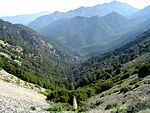 Angeles Angeles
Located in the San Gabriel Mountains at the
edge of the Los Angeles metro area, this
National Forest includes five wilderness
areas. While much of the forest is dense
chaparral, elevations in the forest range
from 1,200 feet (370 m) to 10,064 feet
(3,068 m) at the summit of Mount San
Antonio. |
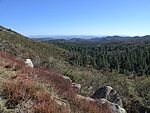 Cleveland Cleveland
In southern California, Cleveland National
Forest has a Mediterranean climate and four
wilderness areas. There are 22 endangered
plant and animal species found in the
forest. With its highest point at 6,271 ft
(1,911 m) on Monument Peak, elevations are
not as high here as in most of California's
other National Forests. |
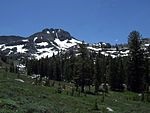 Eldorado Eldorado
In the Sierra Nevada, Eldorado National
Forest has 611 mi (983 km) of fishable
streams and 297 lakes and reservoirs. There
are 349 mi (562 km) of trails and 2,367 mi
(3,809 km) of roads in the forest. The
forest's Desolation Wilderness is the most
visited wilderness area per acre in the
country. |
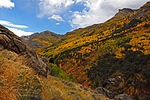 Humboldt-Toiyabe Humboldt-Toiyabe
As the largest National Forest outside of
Alaska, Humboldt-Toiyabe occupies many of
the mountains of Nevada's Basin and Range
Province. Spring Mountains National
Recreation Area is located near Las Vegas
and is part of the forest. This national
forest is also partially located in the
state of Nevada. |
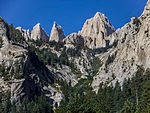 Inyo Inyo
Located in the Sierra Nevada, Inyo includes
Mono Lake, bristlecone pines, the Long
Valley Caldera, nine wilderness areas, and
Mount Whitney, which at 14,505 ft (4,421 m)
is the highest point in the United States
outside of Alaska. This national forest is
also partially located in the state of
Nevada. |
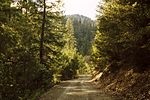 Klamath Klamath
Straddling the California-Oregon border,
this forest has part of five wilderness
areas, 152 mi (245 km) of wild and scenic
rivers, and 200 mi (320 km) of rivers for
rafting, including on the Klamath River.The
Siskiyou mariposa lily is endemic to the
forest, being found nowhere else in the
world. This national forest is also
partially located in the state of Oregon. |
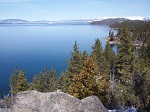 Lake
Tahoe Basin Management Unit Lake
Tahoe Basin Management Unit
The Forest Service lands surrounding Lake
Tahoe are managed by the Lake Tahoe Basin
Management Unit, which was created in April
1973 in order to protect the lake's unique
ecological and recreational values. This
management unit is also partially located in
the state of Nevada. |
 Lassen Lassen
Surrounding Lassen Volcanic National Park,
this forest has three wilderness areas and
92,000 acres (37,000 ha) of old-growth
Sierra Nevada mixed conifer forests. Subway
Cave is a lava tube that is 0.3 mi (0.48 km)
long and open to the public. |
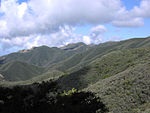 Los
Padres Los
Padres
Encompassing portions of the California
Coast and Transverse ranges of central
California, Los Padres has ten wilderness
areas covering about 48% of the forest.
There are 1,257 mi (2,023 km) of trails and
part of the Jacinto Reyes National Scenic
Byway. |
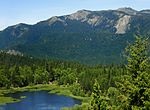 Mendocino Mendocino
Mendocino is the only National Forest in
California not crossed by a paved highway.
The forest's Genetic Resource and
Conservation Center produces plants for
reforestation, watershed restoration,
wildlife recovery, and other projects. |
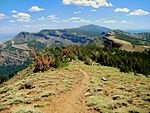 Modoc Modoc
Modoc National Forest contains the Medicine
Lake Volcano, which has an elevation of
7,921 ft (2,414 m) and is the largest shield
volcano in North America. There are 43,400
acres (17,600 ha) of old-growth forest here
along with Mill Creek Falls in the South
Warner Wilderness. |
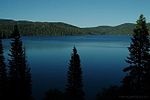 Plumas Plumas
There are 127,000 acres (51,000 ha) of
old-growth forest in Plumas National
Forest.[99] The Little Grass Valley
Recreation Area surrounds Little Grass
Valley Reservoir and includes a campground
and boat launch, among other facilities and
services. |
 Rogue
River-Siskiyou Rogue
River-Siskiyou
This forest ranges from the Cascade Range to
the Siskiyou Mountains, and the Rogue River
drains over 75% of the forest's area. There
are parts of eight wilderness areas in the
forest as well as what may be the world's
tallest pine tree, a ponderosa pine that is
268.35 ft (81.79 m) tall. This national
forest is also partially located in the
state of Oregon. |
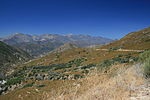 San
Bernardino San
Bernardino
San Bernardino National Forest includes part
of the Santa Rosa and San Jacinto Mountains
National Monument. The forest surrounds Lake
Arrowhead and other reservoirs. |
 Sequoia Sequoia
Sequoia National Forest includes Giant
Sequoia National Monument, both named for
the giant sequoia, the largest tree species
in the world. There are 2,500 mi (4,000 km)
of maintained and abandoned roads and 850 mi
(1,370 km) of trails in the forest,
including the Pacific Crest Trail. |
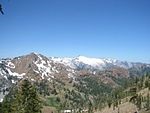 Shasta-Trinity Shasta-Trinity
There are 6,278 mi (10,103 km) of streams in
the forest, and elevations range from 1,000
ft (300 m) to 14,179 ft (4,322 m) on Mount
Shasta. Five wilderness areas and 460 mi
(740 km) of trails can be found in the
forest. |
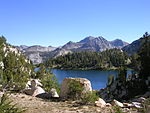 Sierra Sierra
Sierra National Forest is located on the
western slope of the Sierra Nevada and
elevations reach 13,986 ft (4,263 m). There
are 1,800 mi (2,900 km) of streams, 480
lakes, 11 reservoirs, and 63 campgrounds in
the forest. |
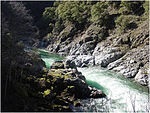 Six
Rivers Six
Rivers
Six Rivers National Forest was named for the
Smith, Klamath, Trinity, Mad, Van Duzen, and
Eel rivers. The forest includes the Salmon
River system, all of which has been
designated a National Wild and Scenic River. |
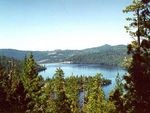 Stanislaus Stanislaus
Stanislaus National Forest has over 800 mi
(1,300 km) of streams and four wilderness
areas, including the Carson-Iceberg
Wilderness. The Emigrant Wilderness borders
the northwest corner of Yosemite National
Park. |
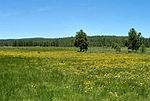 Tahoe Tahoe
Tahoe National Forest is in the Sierra
Nevada northwest of Lake Tahoe. Part of the
Granite Chief Wilderness is within the
forest. The Middle Fork of the American,
Yuba, and North Yuba rivers cross or border
the forest. |
|
|
|
National Parks |
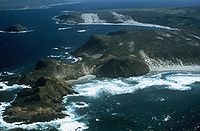 Channel
Islands Channel
Islands
Five of the eight Channel Islands are
protected, and half of the park's area is
underwater. The islands have a unique
Mediterranean ecosystem originally settled
by the Chumash people. They are home to over
2,000 species of land plants and animals,
and 145 are unique to them, including the
island fox. Ferry services offer
transportation to the islands from the
mainland. |
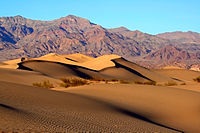 Death
Valley Death
Valley
Death Valley is the hottest, lowest, and
driest place in the United States, with
daytime temperatures that have exceeded 130
°F (54 °C). The park protects Badwater Basin
and its vast salt flats located at the
lowest elevation in North America, −282 ft
(−86 m).[34] The park also protects canyons,
badlands, sand dunes, mountain ranges,
historic mines, springs, and more than 1000
species of plants which grow in this
geologic graben. |
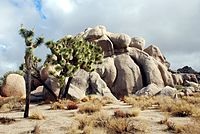 Joshua
Tree Joshua
Tree
Covering large areas of the Colorado and
Mojave Deserts and the Little San Bernardino
Mountains, this desert landscape is
populated by vast stands of Joshua trees.
Large changes in elevation reveal various
contrasting environments including bleached
sand dunes, dry lakes, rugged mountains, and
maze-like clusters of monzogranite
monoliths. |
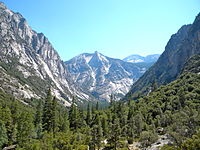 Kings
Canyon Kings
Canyon
Home to several giant sequoia groves and the
General Grant Tree, the world's second
largest measured tree, this park also
features part of the Kings River, sculptor
of the dramatic granite canyon that is its
namesake, and the San Joaquin River, as well
as Boyden Cave.[73] Although Kings Canyon
National Park was designated as such in
1940, it subsumed General Grant National
Park, which had been established on October
1, 1890 as the United States' fourth
national park. |
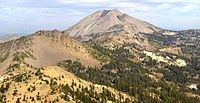 Lassen
Volcanic Lassen
Volcanic
Lassen Peak, the largest lava dome volcano
in the world, is joined by all three other
types of volcanoes in this park: shield,
cinder cone, and composite. Though Lassen
itself last erupted in 1915, most of the
rest of the park is continuously active.
Numerous hydrothermal features, including
fumaroles, boiling pools, and bubbling mud
pots, are heated by molten rock from beneath
the peak. |
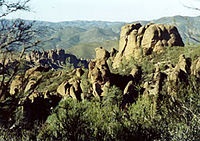 Pinnacles Pinnacles
Named for the eroded leftovers of a portion
of an extinct volcano, the park's massive
black and gold monoliths of andesite and
rhyolite are a popular destination for rock
climbers. Hikers have access to trails
crossing the Coast Range wilderness. The
park is home to the endangered California
condor (Gymnogyps californianus) and one of
the few locations in the world where these
extremely rare birds can be seen in the
wild. Pinnacles also supports a dense
population of prairie falcons, and more than
13 species of bat which populate its talus
caves. |
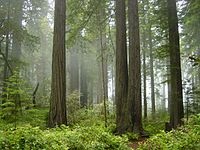 Redwood Redwood
This park and the co-managed state parks
protect almost half of all remaining coastal
redwoods, the tallest trees on earth. There
are three large river systems in this very
seismically active area, and 37 miles (60
km) of protected coastline reveal tide pools
and seastacks. The prairie, estuary, coast,
river, and forest ecosystems contain a wide
variety of animal and plant species. |
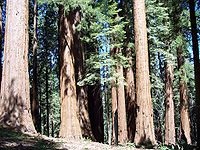 Sequoia Sequoia
This park protects the Giant Forest, which
boasts some of the world's largest trees,
the General Sherman being the largest
measured tree in the park. Other features
include over 240 caves, a long segment of
the Sierra Nevada including the tallest
mountain in the contiguous United States,
and Moro Rock, a large granite dome. |
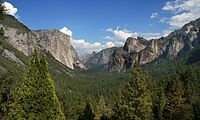 Yosemite Yosemite
Yosemite features sheer granite cliffs,
exceptionally tall waterfalls, and
old-growth forests at a unique intersection
of geology and hydrology. Half Dome and El
Capitan rise from the park's centerpiece,
the glacier-carved Yosemite Valley, and from
its vertical walls drop Yosemite Falls, one
of North America's tallest waterfalls at
2,425 feet (739 m) high. Three giant sequoia
groves, along with a pristine wilderness in
the heart of the Sierra Nevada, are home to
a wide variety of rare plant and animal
species. |
|
|
|
National Monuments |
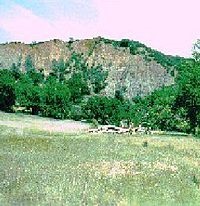 Berryessa
Snow Mountain Berryessa
Snow Mountain
Fewer than 100 miles (160 km) from the San
Francisco Bay Area, Berryessa Snow Mountain
protects part of the California Coast Range,
one of the most biodiverse regions in the
state, home to elk, osprey, river otters,
half the state’s dragonfly species, and
California’s second-largest population of
wintering bald eagles. |
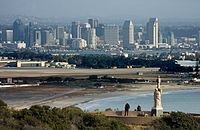 Cabrillo Cabrillo
This monument commemorates the landing of
Juan Rodríguez Cabrillo at San Diego Bay on
September 28, 1542, which was the first
European expedition on what later became the
west coast of the U.S. The monument includes
a statue of Cabrillo and 20th-century
coastal artillery batteries built to protect
the harbor of San Diego from enemy warships. |
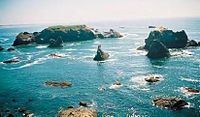 California
Coastal California
Coastal
This monument ensures the protection of all
islets, reefs and rock outcroppings from the
coast of California to a distance of 12
nautical miles (22 km), along the entire
840-mile (1,350 km) long California
coastline. |
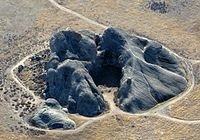 Carrizo
Plain Carrizo
Plain
Carrizo Plain is the largest single native
grassland remaining in California. It
contains part of the San Andreas Fault and
is surrounded by the Temblor Range and the
Caliente Range. At the center of the plain
is Soda Lake, which is near Painted Rock. |
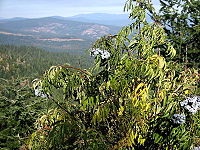 Cascade–Siskiyou Cascade–Siskiyou
One of the most diverse ecosystems found in
the Cascade Range, it has more than 100
dwelling and root-gathering sites belonging
to the Modoc, Klamath, and Shasta tribes.
This national monument is also partially
located in the state of California. |
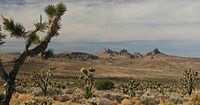 Castle
Mountains Castle
Mountains
Castle Mountains represents some of the most
unique elements of the Mojave Desert.
Nestled between the Nevada state line and
Mojave National Preserve, the nearly 21,000
acres of Castle Mountains boasts Joshua tree
forests, unbroken natural landscapes, rare
desert grasslands, and rich human history. |
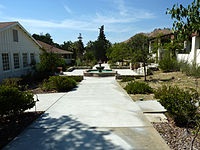 César
E. Chávez César
E. Chávez
This monument commemorates the life and work
of labor leader and civil right activist
Cesar Chavez. Called La Paz, the site was
Chavez's home for about 20 years, and his
gravesite is on the premises. It is also the
location of the headquarters of United Farm
Workers, which was founded by Chavez. |
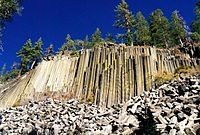 Devils
Postpile Devils
Postpile
Once part of Yosemite National Park, this
monument is a dark cliff of columnar basalt
created by a lava flow at least 100,000
years ago. It also has the 101-foot (31
m)-high Rainbow Falls. |
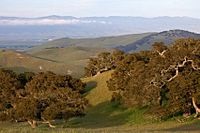 Fort
Ord Fort
Ord
Fort Ord was an Army post from 1917 to 1994.
It now has recreational trails and various
wildlife. |
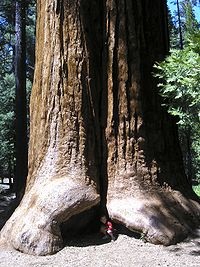 Giant
Sequoia Giant
Sequoia
The monument includes 38 of the 39 giant
sequoia groves in the Sequoia National
Forest, amounting to about half of the
sequoia groves currently in existence. This
includes one of the ten largest giant
sequoias, the Boole Tree. Its two parts are
around Kings Canyon and Sequoia National
Parks. |
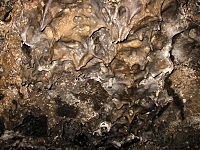 Lava
Beds Lava
Beds
This is the site of the largest
concentration of lava tube caves in North
America. It also includes Petroglyph Point,
one of the largest panels of Native American
rock art. The monument lies on the northeast
flank of the Medicine Lake Volcano, the
largest volcano in the Cascade Range. |
 Mojave
Trails Mojave
Trails
Spanning 1.6 million acres, more than
350,000 acres of previously
congressionally-designated Wilderness, the
Mojave Trails National Monument comprises a
stunning mosaic of rugged mountain ranges,
ancient lava flows, and spectacular sand
dunes. The monument will protect
irreplaceable historic resources including
ancient Native American trading routes,
World War II-era training camps, and the
longest remaining undeveloped stretch of
Route 66. |
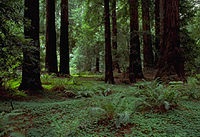 Muir
Woods Muir
Woods
Part of the Golden Gate National Recreation
Area, it protects one of the last old growth
Coast redwood (Sequoia sempervirens) groves
in the San Francisco Bay Area as well as one
of the most easily accessed. |
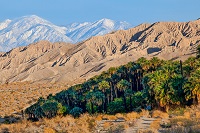 Sand
to Snow Sand
to Snow
The 154,000-acre monument extends from
Bureau of Land Management lands on the
Sonoran desert floor up to over 10,000 feet
in the San Gorgonio Wilderness on the San
Bernardino National Forest. |
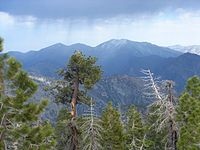 San
Gabriel Mountains San
Gabriel Mountains
Covering 346,177 acres of the San Gabriel
mountains in northern Los Angeles County and
western San Bernardino County, California,
with peaks as high as 10,068 ft (3,069 m),
the San Gabriel Mountains provide one of the
few open-space recreation opportunities
close to residents of Los Angeles County and
is also an important watershed for the Los
Angeles area. |
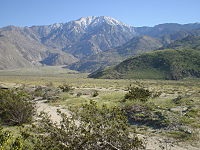 Santa
Rosa and San Jacinto Mountains Santa
Rosa and San Jacinto Mountains
This monument preserves large portions of
the Santa Rosa and San Jacinto ranges, the
northernmost of the Peninsular Ranges. Parts
are within San Bernardino National Forest
and the California Desert Conservation Area. |
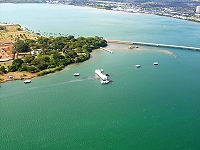 World
War II Valor in the Pacific World
War II Valor in the Pacific
Valor in the Pacific encompasses nine sites
in three states associated with World War
II: The Attack on Pearl Harbor, including
the USS Arizona, Utah, and Oklahoma
memorials in Hawaii; the Aleutian Islands
Campaign on Attu Island, Kiska Island, and
Atka Island in Alaska; and the Japanese
American internment at Tule Lake War
Relocation Center in California. This
national monument is also partially located
in the state of Alaska and Hawaii. |
|
|
Travel America |
|
|
Death Valley National Park
(Beginner - Listening,
reading)
A video lesson which shows you an interesting place in America.
The English is
spoken at 75% of normal speed.
Great English listening and reading practice.
This video is all about Death Valley National Park. |
|
 Travel
America Travel
America
Do you love America and American English? Learn before
you travel. Facts and other cool stuff about your
favorite U.S. state. Visit the Fun Easy English Travel
America pages. Read about the beautiful National
Forests, Parks, and Monuments. Great English reading practice. |
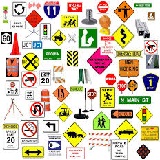 Drive America Drive America
Planning to drive in America? Learn the rules and
regulations. Great English reading practice. |
|